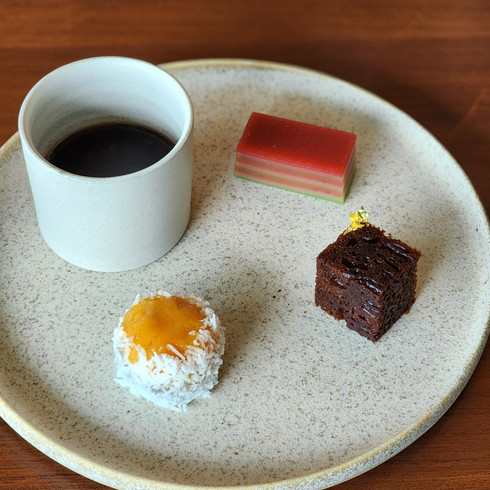Pangium: indulging in Peranakan Culinary Bliss
- DiningMedia
- 2024년 3월 2일
- 5분 분량
Here, chef Malcolm Lee showcases the rich heritage of his culinary background.

Nestled within the lush confines of Singapore's Botanic Garden lies Pangium, a haven of Peranakan culinary heritage. As you embark on the journey to this restaurant, you'll find yourself enveloped in the breathtaking beauty of nature, with verdant greenery stretching as far as the eye can see.
So, what is Peranakan Cuisne?
Peranakan cuisine in Singapore is a delightful fusion of Chinese, Malay, and Indonesian culinary traditions. Also known as Nyonya cuisine, it developed over generations as Chinese immigrants intermarried with local Malays and Indonesians. This unique blend of flavors and techniques results in dishes that are vibrant, aromatic, and full of depth.

Peranakan cuisine is characterized by its bold use of spices and herbs, such as turmeric, lemongrass, and belacan (shrimp paste), which infuse dishes with layers of complex flavors. Signature dishes include laksa, a spicy coconut milk-based noodle soup, and ayam buah keluak, chicken stewed with black nuts for a rich, earthy taste.
Traditionally, Peranakan cuisine reflects the cultural heritage and customs of the Peranakan community, with recipes passed down through generations. Today, it continues to thrive in Singapore, celebrated for its unique blend of flavors and its contribution to the rich tapestry of the city-state's culinary landscape.

Chef Malcolm Lee is a renowned figure in Singapore's culinary scene, celebrated for his dedication to preserving and sharing the flavors of Peranakan cuisine. Despite accolades like a Michelin star and a spot on the World's 50 Best Restaurants Asia list, his true motivation lies in pleasing one discerning critic: his mother. At his restaurant, Candlenut, nestled in Dempsey Hill, Lee pays homage to his Peranakan heritage through intensely flavorful dishes that marry Malay, Indonesian, and Chinese influences.
In a rapidly modernizing Singapore, Lee sees Peranakan cuisine as a vital link to the past, a connection to a time when slow-cooking techniques and hand-pounded spices were the norm. For him, capturing the essence of his mother's cooking is a labor of love, an effort to preserve a culinary legacy for future generations.
Lee's approach to innovation is grounded in a deep respect for tradition. He believes that understanding the roots of a dish is essential to reimagining it for contemporary palates. Through meticulous research and experimentation, he strives to offer guests both familiarity and delight, ensuring that each dish tells a story of heritage and evolution.
Dining Experience in Pangium
The welcome bites. From the delicate Kueh Pie Tee filled with turnips and bamboo shoots to the decadent Crab Cake infused with fermented durian, each bite offers a symphony of flavors and textures. Indulge in the exquisite Ang Kar Sea Prawn Keropok, a nostalgic reminder of Chinese New Year festivities, or savor the flavorful Ngoh Hiang topped with Pok Oy Thong Spiced Powder and braised tea tree mushroom. Especially, I liked the Kueh Pie Tee - a delicate pastry cup filled with turnips, bamboo shoots, and a unique chili sauce sweetened with raisins. Originating from the heart of Peranakan culture in Penang, Melaka, and Singapore, KPT is a beloved pastry that reflects a fusion of British and local influences. The diced turnips added a pleasant texture to the traditional filling, while the sweet chili sauce provided a delightful twist. Each bite transported me to the essence of Peranakan cuisine, steeped in centuries of heritage and tradition.
Next, Pang Susi offered a delightful blend of nostalgia and innovation in Eurasian culinary heritage. Chef Malcolm's dedication brought back this cherished snack, featuring a filling of hand-chopped pork cheek, candied winter melon, and roasted coriander seed, enhanced with Kampot white pepper. Its round form, reminiscent of a polo bun, provided a satisfying crunch!
And, Laksa Johor - inspired by Italian Ragu Spagetti. Fun and easy! Pangium's Laksa Johor showcased bold flavors and rich heritage. Originating from Sultan Abu Bakar's royal kitchens, this unique laksa invited indulgence with its thick gravy and rich sauce made from galangal, dried shrimp, and threadfin powder. Topped with fresh herbs and salted chai poh, each bite showcased the culinary artistry of Johor.
My experience with Spicy Mee Sua was a delightful journey into chef's cherished family traditions. This dish, passed down through generations, holds a special place in chf Malcolm's heart and culinary repertoire. While traditionally prepared with oyster meat and mini meat patties in a gravy-style preparation, Pangium introduces a dry-style twist to elevate the flavors. Mee sua, symbolizing longevity with its unbroken length of noodle, adds a special touch to this dish, making it a must-have for many communities from the Fujian region in China.
Next was Pumpkin Bakwan Kepiting Soup. The comforting flavors of this Soup is an homage to festive gatherings in Peranakan households. Traditionally prepared with ground pork and crab meatballs, chef features a delightful twist with chicken. Bakwan (Hokkien for meatball) and Kepiting (Malay for crab) come together in a delicate soup, where the Kabocha pumpkin enhances the richness with its natural sweetness and dense, meaty flesh. Presented with bakwan nestled between two tofu puffs.
Right side of the photo is Ikan Masak Lemak. Featuring Glacier51 toothfish and bouchot mussels, complemented by sweet potato leaf and koshihikari rice, this dish celebrates the delicate balance of coconut milk and fresh seafood. Literally translated as "Fish cooked in coconut milk," Ikan Masak Lemak embodies the essence of Malaysian cuisine, offering a harmonious blend of creamy richness and succulent seafood.
Main course was S.O.S Buah Keluak Beef Stew & Perfumed Rice. This menu is inspired by Chef Malcolm's grandmother's Nyonya Chicken Stew. The rich earthy tones of buah keluak with tender beef and fragrant vegetables, celebrating comfort and tradition. The perfumed rice, crafted with Basmati rice from the Himalayas and infused with butter, ginger, garlic, clove, and star anise, added a delightful aroma to every bite. Served with Sambal Belachan according to family tradition, this dish truly captured the warmth and richness of home-cooked meals.
Time for dessert Experiencing the refreshing delight of Fresh Aiyu & Bai He dessert was a harmonious blend of tradition and innovation. The Ai-Yu jelly, made from fig seed gel, embodied natural sweetness and freshness, reminiscent of Taiwan's culinary heritage now embraced in Singapore's food culture. Crafted in-house using traditional methods, the Aiyu Jelly was topped with lily bulb for purity, bird's nest for luxury, and Eucalyptus honey and Calamansi shave ice for a burst of flavors and textures, offering a rejuvenating celebration of life.
Kuehs & Sweets: we had delightful bites of different flavors. Inside a small cup, Pulut Hitam Red Bean Soup offered a harmonious blend of flavors inspired by Chef's family recipe. Combining the sweetness of pulut hitam and red beans with the tang of dried logan and the aromatic essence of 30 years aged tangerine, each spoonful provided a comforting warmth and exotic burst of flavors. Also Kek Sarang Semut was a delightful experience of a traditional Indonesian cake with a unique texture resembling an ant's nest or bee hive. Chewy with a lot of moisture! Made with butter and white sugar, this sweet and caramelized cake boasted a soft and bouncy texture that satisfied sweet cravings with simple ingredients done well.
Treating myself to the multicolored - red and green- layers of Lapis Sagu was a delightful experience of a beloved Indonesian and Singaporean delicacy. Meticulously steamed layer by layer, it offered a nice balance of sweetness and fragrance, leaving a delightful aroma of pandan and coconut with every bite. Lastly, Kuih Putugal is made with Cempedak or Banana, coated with tapioca and grated coconut, these bite-sized treats were a delightful recreation at Pangium.

If you're eager to explore the nuances of refined Peranakan cuisine, look no further than Pangium. Nestled amidst the verdant beauty of Singapore's Botanic Garden, Pangium beckons with its exquisite offerings that pay homage to the rich culinary heritage of the Peranakan culture!










































댓글